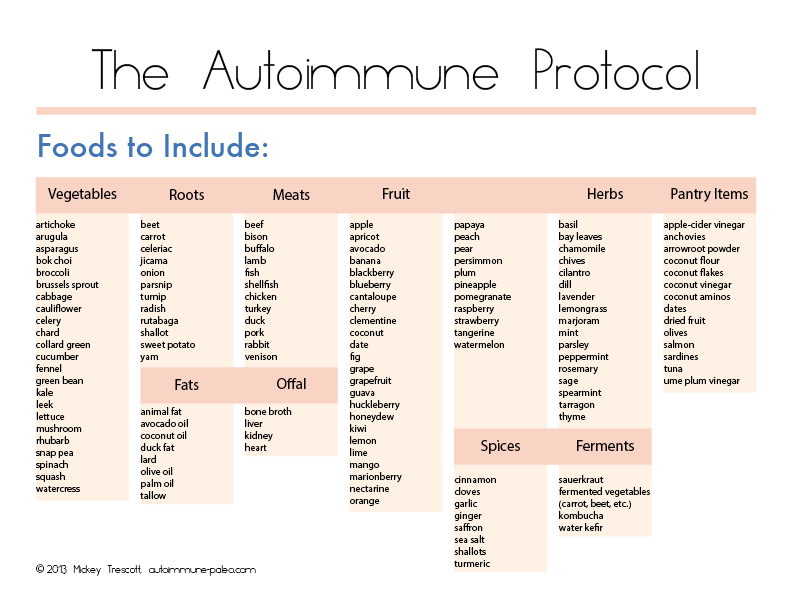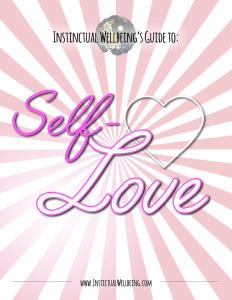The autoimmune protocol (AIP) diet was created by Dr. Sarah Ballantyne as one possible answer to battling autoimmune conditions. The basic function of the diet is to do three main things: reduce inflammation in the body, encourage a normal functioning of the immune system and promote healing.
Dr. Ballantyne has written a beautiful 400+ page book called The Paleo Approach that intricately explains all the inner workings of not only the diet, but about how and why autoimmune diseases occur and how to manage them holistically through diet, nutrition and lifestyle. I’d highly recommend you read through that book, as it is what is referred to as the “Bible of the autoimmune community”; however, I’m going to do my best to highlight some of the main points regarding the diet below, in hopes that it can get you started on your own AIP healing journey.
What is an autoimmune condition?
Today, there are more than 100 classified autoimmune conditions and even more that may have origins in the immune system. The American Autoimmune Related Diseases Association estimates that 50 million Americans suffer from at least one autoimmune condition; this is double the amount of people who suffer from heart disease and more than 4x the amount who suffer from cancer.
An autoimmune condition is quite simply put as when your immune system begins to attack your own body. Fun, right? In more scientific terms, Dr. Ballantyne describes an autoimmune condition as when “our immune system, which is supposed to protect us from invading microorganisms, turns against us and attacks our cells instead.” (The Paleo Approach, pg.12)
Examples of commonly diagnosed autoimmune diseases include psoriasis, Hoshimoto’s thyroiditis, rheumatoid arthritis, diabetes type 1, ankylosing spondylitis, Celiac disease, Crohn’s disease and ulcerative colitis.
There are also conditions that commonly go hand-in-hand with autoimmune conditions, such as chronic fatigue syndrome, fibromyalgia, PCOS and eczema. These are currently not classified as “official” autoimmune conditions, but they usually suggest that an autoimmune disease is present in the body, so it is probably time to make diet and lifestyle changes to help manage these troubling conditions.
What causes autoimmune disease?
Sadly, it’s still not completely understood what exactly causes autoimmune conditions. However, according to Dr. Ballantyne, three factors that definitely contribute to their formation are:
- Genetics
- Infection or environmental triggers
- Diet and lifestyle
For me (and many people I’ve talked to), I believe that my autoimmune diseases were “made possible” by my genetic predisposition to them, but that doesn’t mean I was absolutely going to have them; this is something that I always stress in any aspect of health – that just because you are genetically susceptible to a condition or disease, does NOT mean that you’re automatically doomed to suffer from it (research “epigenetics” for more information). In other words, while I may have had autoimmune diseases buried in my genes, I had control over whether or not that gene got switched “on” or whether it lay dormant my whole life, like a sleeping volcano that never actually erupts.
That said – in my case, after many warning signs and “trembles”, my sleeping volcano did finally erupt, and I attribute that to the other two factors listed above: environmental triggers, and diet and lifestyle. Essentially, the stressors of life and work (new job, moving, a bad break-up, etc.), along with cramming my body full of stimulants and inflammatory foods like dairy, gluten, sugar and nightshades (tomatoes, potatoes, peppers, etc.) came to a head and landed me in bed for a matter of months as my system tried to recover and settle down.
So for me, it wasn’t just one thing that caused me to begin experiencing autoimmune conditions; it was a myriad of factors that all came together as the “perfect storm” and ignited the sleeping volcano that was my autoimmune conditions.
How can the autoimmune protocol (AIP) diet help?
Again, the autoimmune protocol is designed to fight inflammation, regulate the immune system, and aid in actually healing (as opposed to just dampening symptoms with medication) your system from the root cause of the disease, which often lies in healing the gut. The other thing that it helps with by nature is increasing the amount of nutrient-dense foods that you are consuming.
Before I started the AIP diet, I didn’t do a very good job of choosing a variety of nutrient-dense, whole foods. Since this diet is based on eating high-quality meats, fruits, vegetables, fermented foods and bone broths, it’s extremely nourishing to the body and helps you increase the amounts of macro and micronutrients you’re getting each day. It goes without saying, but the amount of nutrients coming from whole foods (not just a multivitamin) each day can drastically improve the way you feel mentally, physically and even emotionally; when you’re body is in alignment, balanced and properly fueled, your quality of life definitely improves!
What I find most helpful from the AIP diet though is my ability to manage stress has drastically improved. It has been said that more than 40% of stressors originate from the diet, not from running around, working, or dealing with life. To me, that was mind-blowing, and all the more reason to pay attention to my diet. I learned that when you choose to nourish your body and properly fuel it with whole foods instead of stimulants like caffeine, sugar and processed foods, your hormones are stabilized, your adrenal glands (responsible for your “flight or fight” response) react properly (i.e. no feeling like you’re going to have a full-blown panic attack if you’re running five minutes late or your email crashes), and your brain feels mentally prepared to deal with the natural setbacks or disappointments that are just a part of life. As someone who has suffered from chronic, crazy anxiety his whole life, this new, balanced state of my body was incredibly refreshing and encouraging.
Again – for more information on how the AIP diet can help you manage your autoimmune conditions and achieve optimal health, I highly encourage you to read Dr. Ballantyne’s book or visit her website, because there’s about 200 more pages worth of material I’d love to cover but won’t be able to within this one blog post.
Is the autoimmune protocol the same as paleo?
This is one of the questions I get asked the most, and understandably so, as yes – the autoimmune protocol is basically a modified version of the paleo diet. By that I mean that it takes the premise of the paleo diet guidelines and expands upon them to cater to those who are living with autoimmune conditions.
In the paleo diet, the following food groups are omitted:
- Grains (yes, even gluten-free grains like oats and rice)
- Legumes (beans, peas, peanuts)
- Dairy
- Soy
- Corn
- White potatoes (sweet potato varieties allowed, as these are actually considered root vegetables and not potatoes)
- Processed sugar (coconut sugar, pure maple syrup, honey are allowed)
- Refined oils (canola, safflower, grapeseed, peanut, etc.)
- Processed foods
In the autoimmune protocol, you take the above list and ALSO omit the following food groups:
- Eggs
- Nightshade vegetables (tomatoes, peppers, eggplant)
- Nuts & seeds
- Coffee
- Chocolate
- Alcohol
- optional: high-glycemic fruits (like bananas, mango and peaches)
Now, if this is your first exposure to this diet, you might be about to hit “X” on your browser button because you’re feeling overwhelmed and as if you could never possibly omit all of these different food groups. But don’t! Stay with me. I realize this can sound really intimidating, but I want to point out two things:
1) Many people only need to do the protocol for 30 days and then they can start reintroducing foods back in, so this doesn’t have to be a long-term solution for everyone (although some, like myself, prefer to integrate the basics of the diet into their everyday lifestyle for much longer than that), and
2) I promise you, there are still PLENTY of foods and options that you can eat while on the diet, and that you’re going to unlock a whole new way of living, eating and nourishing your body while following it. So, I highly encourage you to not think of the “glass half empty” and instead, focus on all of the delicious, whole foods that you CAN eat as part of the protocol. In The Paleo Approach, there are literally 3.5 entire pages of about size 10 font worth of foods that you can enjoy while following the protocol. However, here is a brief list to get you started, provided by Mickey Trescott over at AutoimmuneWellness.com.
How long do I have to follow the AIP diet?
As I mentioned above, this really does vary for everyone. Some people follow it for 30 days and then begin to reintroduce foods and find that they feel great. Others do it for 3 months, 6 months or even a year before trying to add back in foods (the “goal” being to eventually “reintroduce” all AIP-restricted foods). For me personally, I was in such bad shape physically that I adhered to a very strict AIP diet for about 4 months before trying to add back in anything. Then, I started by just reintroducing small amounts of mustard (which is considered a seed) and REAL chocolate (no additives), and then small amounts of coffee on occasion. I stayed at that point for about another 10 months before moving on to the next stage, which – for me – was reintroducing raw almonds and some higher glycemic fruits like mango and peaches (I chose to eliminate those for a long time because I was also pre-diabetic and struggled a ton with blood sugar issues, which is common with autoimmune conditions).
So, you can see that it just depends on your body and what it needs. For me, I obviously needed to adhere to the diet fairly strictly for about a year, and definitely for the first 4 months or so. For others, they treat the diet as more of a chance to push the “reset button” and establish some new, healthy boundaries and dietary habits for themselves, then they reintroduce things after 30 or 60 days.
Regardless of what you choose to do though, I will say that the standard is to do the diet for at least 30 days; this gives the body a chance to cleanse and begin to rebuild and heal itself. It also gives you a fair shot experiencing for yourself the benefits of the diet so you can make an educated decision about when (and what) to reintroduce back into your diet when you’re ready.
How do I know if the AIP diet is right for me?
If you believe you have an autoimmune condition (even if doctors “can’t figure out what’s causing you to feel crappy”), then the AIP diet is right for you. Basically, if you feel tired, sick, frustrated because doctors can’t figure out what’s wrong with you (or just want you to take 100 pills), “foggy” in the head, in pain, experience horrible allergies, have digestive problems and/or struggle with hormonal imbalances, I can almost guarantee that the AIP diet would be transformative for you. The reason I say this is that at the root cause of nearly all disease is inflammation, and the AIP diet is designed specifically to be a powerful anti-inflammatory diet. So, whether you’re struggling with an autoimmune condition or even if you’re not, giving the protocol a shot can have amazing benefits for your health and overall wellbeing.
What I always say though is that the best way to know if it’s right for you is just to try it. Try it for 30 days and just see. Trust me, if you truly commit yourself to following the diet for 30 days, you’ll know by the end of it whether or not the diet is something worth continuing.
OK I’m ready to do it! Now what?
The first thing you’ll want to do is familiarize yourself with what is allowed on AIP and what is not. The Paleo Approach book is by far the most comprehensive resource for this, but you can also get most of the information for free at The Paleo Mom’s website and the AutoimmuneWellness website.
Once you know what the guidelines are, you’re ready to do some meal prepping and get to the grocery store. I highly recommend searching on Google and Pinterest for “paleo aip recipes” or just “aip recipes”, or checking out our recipes here on Instinctual Wellbeing. Additionally, if you are on Instagram, I cannot stress enough how many amazing bloggers, resources and supportive followers there are to help those following the diet. Just try searching for hashtags like #aipdiet, #autoimmuneprotocol, #autoimmunepaleo or #paleoaip to find an endless array of amazing recipe ideas, lifestyle posts, and encouraging people to follow and make friends with in the community.
Once you have your game plan for what you’re going to cook that week (psst – check out our meal planning 101 post to help you get started), it’s time to get to the store. When you’re shopping, remember to always read the label and make sure that you can understand all the ingredients. At first, your safest bet will be to just stick to the perimeter of the grocery store so you can focus on buying fresh foods like produce and meats, instead of processed foods that may contain ingredients that aren’t AIP-friendly. If you’re looking for budget-friendly ways to do shop, I recommend checking out my previous post on how to be paleo on a budget because I know that sometimes eating healthy can feel pricey.
And there you have it – you’re well on your way to being an AIP pro! Just remember that while this may seem completely overwhelming and foreign to you, there are so many great resources out there nowadays to help you along in your journey, and even specific support groups set up throughout the country to help you on your journey to overcoming autoimmune conditions and reclaiming your health (look under the Medical + Local Resources section on the linked page). You’re not alone in this and you CAN do it! I promise. It may seem difficult at first, but before you know it, you’re going to be feeling better and naturally making healthy choices because this protocol and lifestyle will just become a part of your everyday life.
For an amazing list of resources to help you with your AIP journey, I recommend checking out the list of AIP & healing resources right here on our site.
Best of luck in your healing!





Wow! Great article. Have got a clear understanding. Thanks for sharing it with us, Mitch.